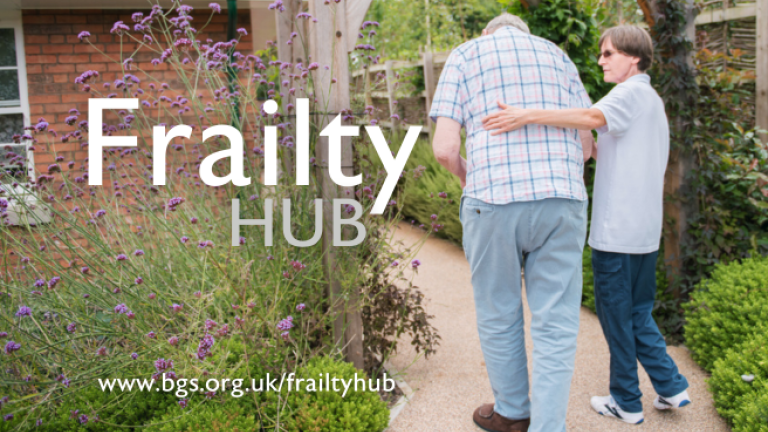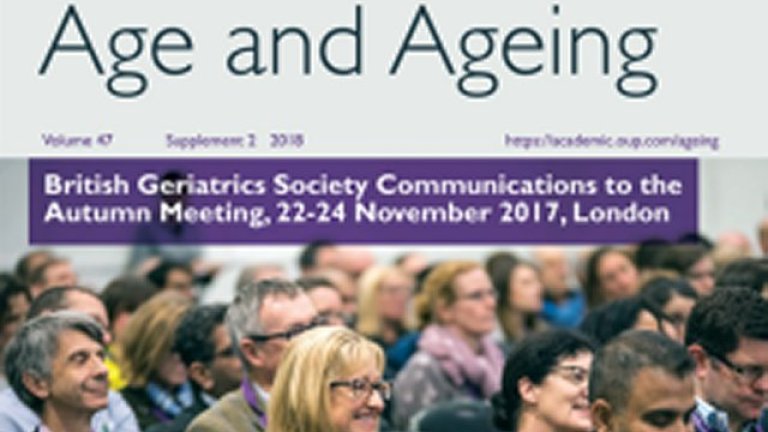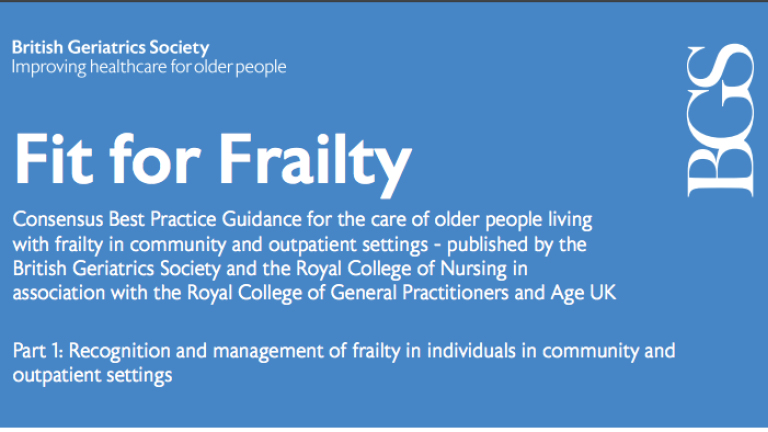Age and Ageing collection: Frailty in older people
Frailty is rightly now recognised as a key concept underpinning health problems in later life; at its core it is ' a condition or syndrome which results from a multi-system reduction in reserve capacity to the extent that a number of physiological systems are close to, or past, the threshold of symptomatic clinical failure. As a consequence the frail person is at increased risk of disability and death from minor external stresses ’ (Campbell and Buchner, Age and Ageing 1997;26:315-8).
There is no perfect frailty measure or scale, although approaches include defining a phenotype (in which specific characteristic such as muscle weakness, slow walking speed, weight loss, reduced activity and exhaustion are measured) or the deficit accumulation model (in which a wide range of potential deficits are measured and enumerated as a ratio). A potential advantage of the latter is that it can be derived from a range of routine data sources in common use.
Over the last 10 years there has been an explosion of interest in frailty. The British Geriatrics Society and key partners have collaborated on developing guidance on the clinical care and system level requirements to deliver excellent urgent care for frail older people (the Silver Book ). This work has led to an increased focus on urgent care of frail older people across the UK and increasingly in Europe.
Age and Ageing has contributed substantially to the knowledge and understanding of the subject. This Virtual Issue gathers together selected frailty publications from the journal. It covers many of the main issues including describing the condition conceptually, reporting its epidemiology, contrasting different options for clinical assessment, detailing the adverse outcomes of frailty in older subjects, and lastly and perhaps most importantly providing insights into what interventions might improve outcomes for frail older subjects (and their carers).
By grouping these articles together and making them available on-line, we hope to further encourage clinicians and researchers to develop and refine their thinking in assessment and management of frail older people. These articles reinforce how far frailty has come; now not just an abstract concept, but with an established and important place in the health-care of older people.
David Stott (Editor-in-Chief)
Simon Conroy (Associate Editor)
Ruth E. Hubbard (Associate Editor)
What is Frailty?
• Unstable disability and the fluctuations of frailty. Campbell AJ. Buchner DM. Age & Ageing. 26(4):315-8, 1997 Jul.
This seminal paper broke new ground in identifying frailty as a state of unstable disability. It also emphasised that frailty includes both physical and cognitive impairment domains.
• What would make a definition of frailty successful? Rockwood K. Age & Ageing. 34(5):432-4, 2005 Sept.
A step-by-step guide explaining why a definition of frailty should have content validity, construct validity and be able to identify people at greater risk of adverse outcomes.
• The frailty phenotype and the frailty index: different instruments for different purposes. Cesari M. Gambassi G. Van Kan GA. Vellas B. Age & Ageing. 43(1):10-12, 2014 Jan.
Emphasises the differences between the frailty phenotype and frailty index, and explains that both are valid measures but are used for different purposes.
• Is grip strength a useful single marker of frailty?. Syddall H. Cooper C. Martin F. Briggs R. Aihie Sayer A. Age & Ageing. 32(6):650-6, 2003 Nov.
A core feature of frailty definitions is impaired muscle strength - this paper neatly demonstrated that lower grip strength is an important independent predictor of adverse outcomes.
• New horizons in frailty: ageing and the deficit-scaling problem. Howlett SE. Rockwood K. Age & Ageing. 42(4):416-23, 2013 Jul.
An innovative overview of scaling: how subcellular damage may lead to macroscopic deficits and give rise to frailty.
• An assessment of neurocognitive speed in relation to frailty. Rolfson DB. Wilcock G. Mitnitski A. King E. de Jager CA. Rockwood K. Fallah N. Searle SD. Age & Ageing. 42(2):191-6, 2013 Mar.
Historically there has been debate about whether or not cognition should be included in frailty definitions - this paper demonstrated that cognitive processing power is reduced in older people with frailty.
• Frailty in the older surgical patient: a review. Partridge JS. Harari D. Dhesi JK. Age & Ageing. 41(2):142-7, 2012 Mar.
This paper led the way in emphasising the importance of frailty assessment in older surgical patients - taking frailty to new populations.
• Prevalence of frailty and disability: findings from the English Longitudinal Study of Ageing. Gale CR. Cooper C. Sayer AA. Age & Ageing. 44(1):162-5, 2015 Jan.
Epidemiology of frailty and the associated difficulties in performing basic and extended activities of daily living.
Aetiology and pathophysiology
• Orthostatic haemodynamics may be impaired in frailty. Romero-Ortuno R. Cogan L. O'Shea D. Lawlor BA. Kenny RA. Age & Ageing. 40(5):576-83, 2011 Sep
Cross-sectional study showing orthostatic heart rate response and blood pressure control are impaired in frail older people.
• Exploring the relationship between national economic indicators and relative fitness and frailty in middle-aged and older Europeans. Theou O. Brothers TD. Rockwood MR. Haardt D. Mitnitski A. Rockwood K. Age & Ageing. 42(5):614-9, 2013 Sep.
This secondary analysis of the European SHARE data (n = 36,306) revealed that in higher-income countries, the prevalence of frailty is lower and frail people also live longer.
• The association between dehydroepiandosterone and frailty in older men and women. Voznesensky M, Walsh S, Dauser D, Brindisi J, Kenny AM. Age and Ageing 2013;42(3):352-59.
Cross-sectional study showing frailty is associated with lower dehydroepiandosterone levels.
• The association of frailty with serum 25-hydroxyvitamin D and parathyroid hormone levels in older European men. Tajar A. Lee DM. Pye SR. O'Connell MD. Ravindrarajah R. Gielen E. Boonen S. Vanderschueren D. Pendleton N. Finn. JD. Bartfai G. Casanueva FF. F
Cross-sectional investigation reporting an association between lower 25- hydroxyvitamin D / higher parathyroid levels and frailty status in older men.
Clinical assessment and outcome prediction
• Validity and reliability of the Edmonton Frail Scale. Rolfson DB. Majumdar SR. Tsuyuki RT. Tahir A. Rockwood K. Age & Ageing. 35(5):526-9, 2006 Sep.
This is an earlier paper that launched one of the best known frailty rating tools - the Edmonton Frailty Scale.
• Characterising frailty in the clinical setting--a comparison of different approaches. Hubbard RE. O'Mahony MS. Woodhouse KW. Age & Ageing. 38(1):115-9, 2009 Jan.
Cross-sectional study that compared different frailty measures across the spectrum of frailty severity; some frailty measures have a 'floor' effect and do not discriminate between patients at the more severe end of the frailty spectrum.
• The frailty index in Europeans: association with age and mortality. Romero-Ortuno R. Kenny RA. Age & Ageing. 41(5):684-9, 2012 Sep.
A longitudinal study validating the Frailty index as a stronger predictor of mortality than age in a large European population.
• Examining three frailty conceptualizations in their ability to predict negative outcomes for home-care clients. Armstrong JJ. Stolee P. Hirdes JP. Poss JW. Age & Ageing. 39(6):755-8, 2010 Nov.
This large study demonstrated frailty's predictive capacity using routine home care datasets and made way for routine data driving better management of frailty in primary care.
• Frailty and use of health and community services by community-dwelling older men: the Concord Health and Ageing in Men Project. Rochat S. Cumming RG. Blyth F. Creasey H. Handelsman D. Le Couteur DG. Naganathan V. Sambrook PN. Seibel MJ. Waite L. Age & Ageing. 39(2):228-33, 2010 Mar.
Observational study showing that frailty is strongly associated with increased use of health and community services in community-dwelling older men.
• The predictive properties of frailty-rating scales in the acute medical unit. Wou F. Gladman JR. Bradshaw L. Franklin M. Edmans J. Conroy SP. Age & Ageing. 42(6):776-81, 2013 Nov.
This study reported the limited ability of five frailty measures to predict adverse outcomes for older people attending two acute medical units
• The impact of frailty and delirium on mortality in older inpatients. Eeles EM. White SV. O'Mahony SM. Bayer AJ. Hubbard RE. Age & Ageing. 41(3):412-6, 2012 May.
This work highlights how frailty interacts with established geriatric syndromes such as delirium, to increase the likelihood of adverse outcomes.
Treatment and clinical care
• The impact of frailty on the utilisation of antithrombotic therapy in older patients with atrial fibrillation. Perera V. Bajorek BV. Matthews S. Hilmer SN. Age & Ageing. 38(2):156-62, 2009 Mar.
Frail older patients with atrial fibrillation were significantly less likely to receive warfarin than non-frail and appear more vulnerable to adverse clinical outcomes, with and without antithrombotic therapy
• Effects of dehydroepiandrosterone (DHEA) on cardiovascular risk factors in older women with frailty characteristics. Boxer RS. Kleppinger A. Brindisi J. Feinn R. Burleson JA. Kenny AM. Age & Ageing. 39(4):451-8, 2010 Jul.
This randomised, placebo controlled trial of frail older women showed that administration of dehydroepiandrosterone had no adverse effect on cardiovascular risk factors.
• A systematic review of comprehensive geriatric assessment to improve outcomes for frail older people being rapidly discharged from acute hospital: 'interface geriatrics'. Conroy SP. Stevens T. Parker SG. Gladman JR. Age & Ageing. 40(4):436-43, 2011 Jul.
This paper summarised the clinical evidence for managing frail older people across the secondary-primary care interface, so called 'interface geriatrics'
• The effect on caregiver burden of a problem-based home visiting programme for frail older people. Melis RJ. van Eijken MI. van Achterberg T. Teerenstra S. Vernooij-Dassen MJ. van de Lisdonk EH. Rikkert MG. Age & Ageing. 38(5):542-7, 2009 Sep.
Randomised controlled trial exploring caregiver effects of a nurse-led comprehensive geriatric evaluation and management programme for community-dwelling frail older people; no overall carer benefits were seen, however a subgroup analysis found that the intervention may help caregivers who live with the patient.
• Effects of exercise training on bone mineral density in frail older women and men: a randomised controlled trial. Villareal DT. Steger-May K. Schechtman KB. Yarasheski KE. Brown M. Sinacore DR. Binder EF. Age & Ageing. 33(3):309-12, 2004 May.
In one of the earliest studies to classify participants according to precise frailty criteria (reduced aerobic power, poor performance on physical tests, difficulty with ADLs), an intense exercise regime had no significant effect on bone mineral density.
• Effect of a multifactorial, interdisciplinary intervention on risk factors for falls and fall rate in frail older people: a randomised controlled trial. Fairhall N. Sherrington C. Lord SR. Kurrle SE. Langron C. Lockwood K. Monaghan N. Aggar C. Cameron ID. Age & Ageing. 43(5):616-22, 2014 Sept.
Although an individualised home exercise program improved the falls risk factor profile it failed to reduce the number of falls.
• The Home-based Older People's Exercise (HOPE) trial: a pilot randomised controlled trial of a home-based exercise intervention for older people with frailty. Clegg A. Barber S. Young J. Iliffe S. Forster A. Age & Ageing. 43(5):687-95, 2014 Sept.
Pilot study showing the feasibility of a prolonged (12-week) exercise program for frail older people.
Fit for Frailty – a British Geriatrics Society campaign
The British Geriatrics Society (BGS) has launched the first of a two-part guidance on the recognition and management of older patients with frailty in community and outpatient settings. Called Fit for Frailty, it has been produced in association with the Royal College of General Practitioners (RCGP) and Age UK, and aims to be an invaluable tool for social workers, ambulance crews, carers, GPs, nurses and others working with older people in the community. The guidance will help in recognition of the condition of frailty and increase understanding of the strategies available for managing it.
In the guidelines, the BGS calls for all those working with older people to be aware of, and assess for frailty. It dispels the myth that all older people are frail and that frailty is an inevitable part of ageing. It also highlights the fact that frailty is not static; like other long term conditions it can fluctuate in severity.



